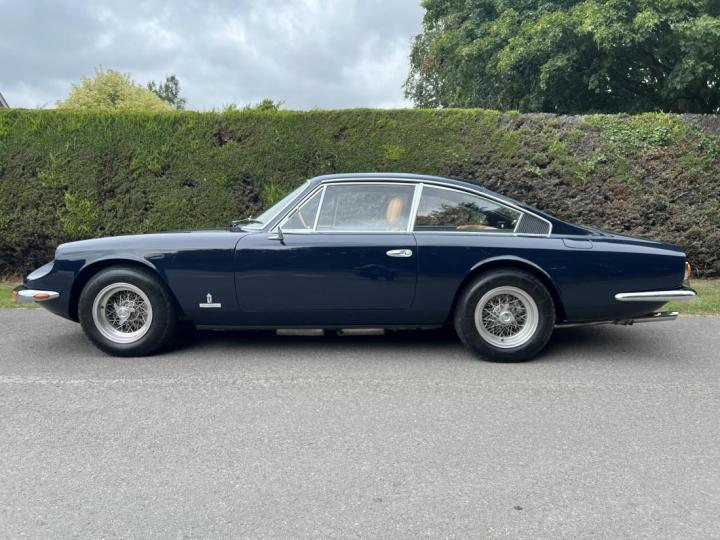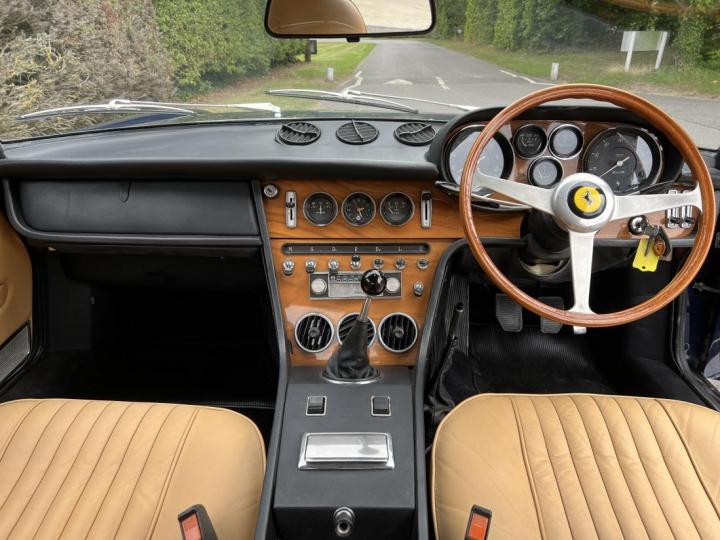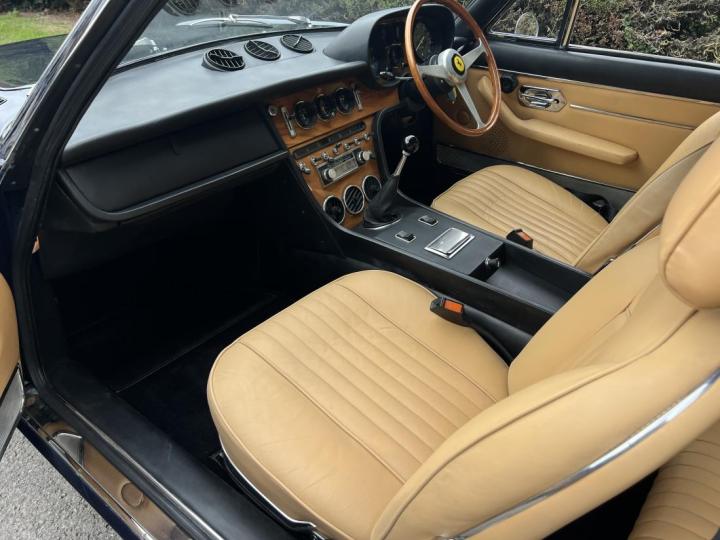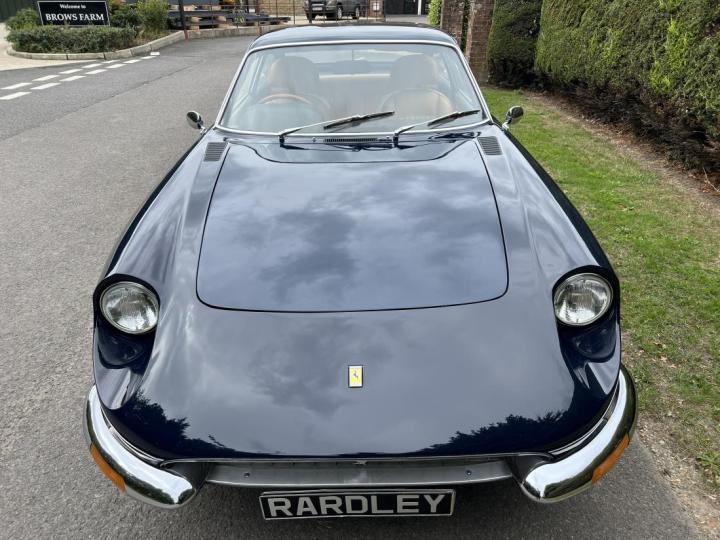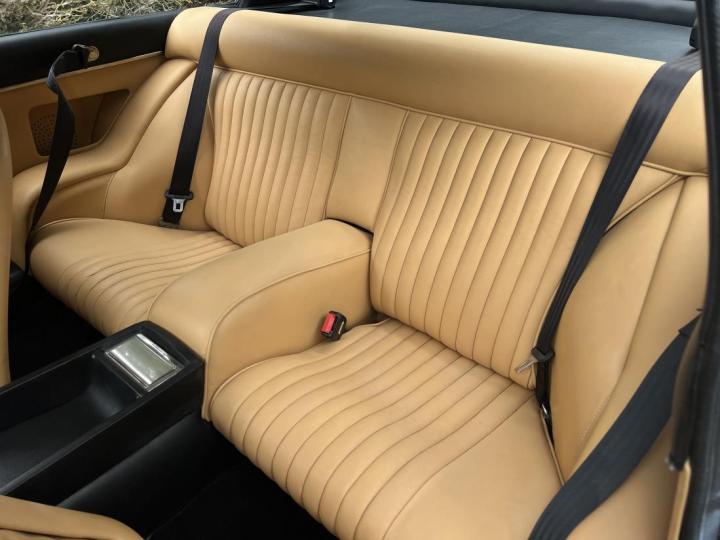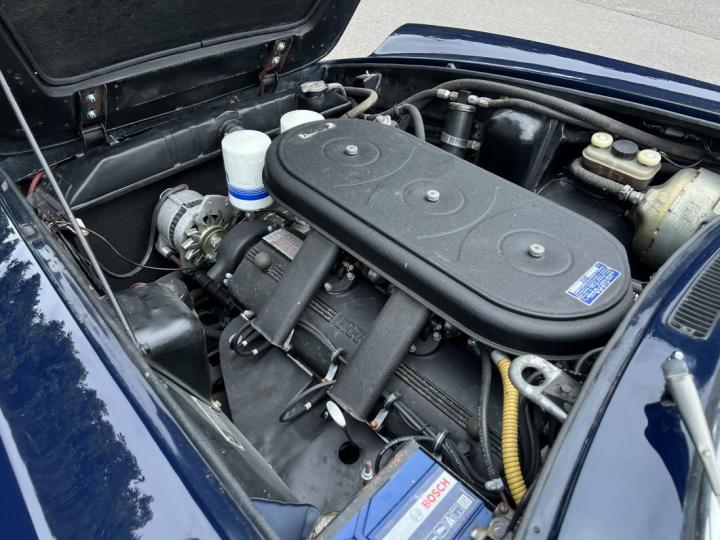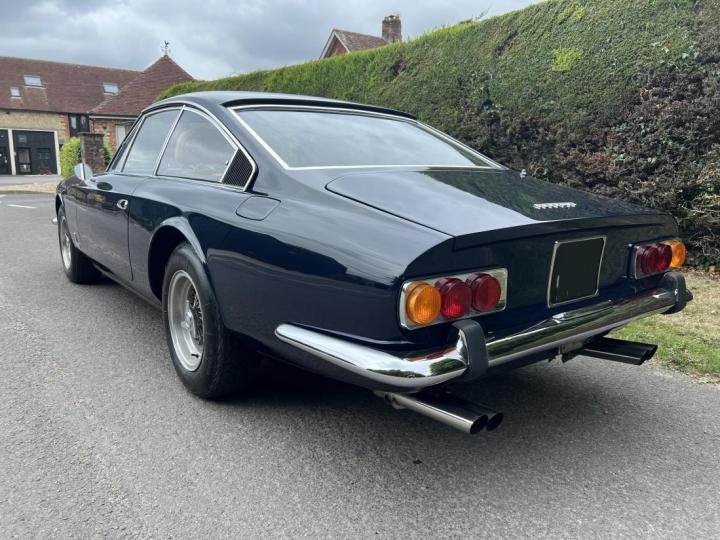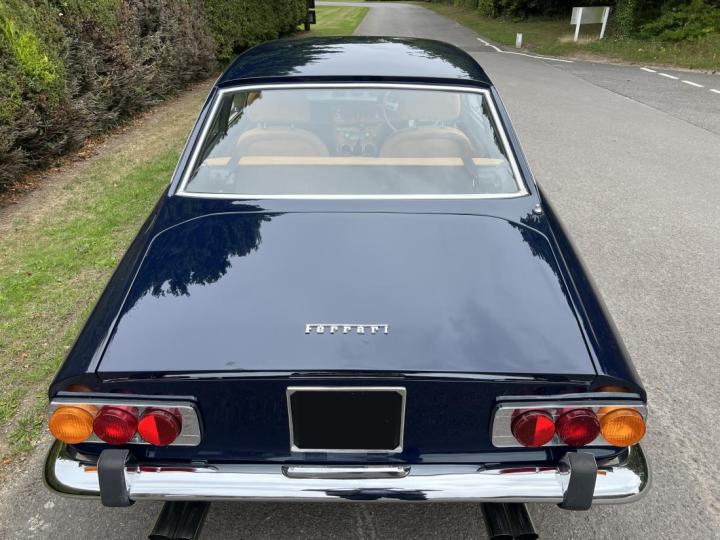Ordered by Maranello Concessionaires Ltd (order number 423), this car was completed by the Ferrari factory in January 1970. It was finished in Amaranto Bull Lea—a shade named after an American racehorse—with beige VM3218 Connolly hide and dark red carpets. Factory options included air conditioning, a radio, and alloy wheels.
Upon completion, the car was collected from the factory by its first owner, Mr I.H., on Italian export plates (EE number plates). The UK price at the time was £8,748.10s.4d plus delivery, number plates, and road tax—the same price as a new 365 GTB/4 “Daytona.” It was one of just 52 examples officially imported by Maranello Concessionaires, of which only 25 are known to survive taxed or SORN’d.
It is believed that Mr H toured Europe in the car before returning with it to South Africa, where it was registered *** ****.
The next owner, Dutchman Mr V.B., discovered the car in South Africa with approximately 65,000 miles while travelling for work as a spice dealer. In August 1986, he shipped the car to Holland aboard the Conti Harmonia from Durban.
Mr V.B. then sent the car to renowned restorer Kevin O’Rourke of Moto Technique in Chertsey, Surrey, for appraisal. Kevin’s March 1987 estimate included 365 hours for bodywork and 176 hours for retrimming. The car was fully stripped (photographed during the process), jigged, and rebuilt with new wings and door skins. It was repainted in its current colour—Blu Scuro (dark blue)—and retrimmed in new beige Connolly hide and beige Wilton carpets, matching the original specification.
The car was completed in time for the Ferrari Owners' Club Concours at Brocket Hall in July 1988. On the Friday prior, Supercar Classics photographed the car for an upcoming feature, with Kevin driving. During the shoot on the A303 in Somerset, they pulled over to photograph the car in a field. Kevin recalls a Land Rover speeding towards them—presumably the landowner, angered by the intrusion. Not wishing to wait, Kevin started the Ferrari and made a hasty exit from the field . The Ferrari outran the Land Rover and returned safely to the Surrey workshop, where it was cleaned and prepared for the Concours. The incident did no harm—the car placed second in its class with 336 points, much to everyone's relief.
Mr V.B. returned to Holland with the car, which was registered RN-290-HJ. Shortly after the Concours, he contacted Modena Engineering in East Horsley, Surrey. A deal was struck, and they travelled to Holland to collect the car and drive it back to the UK. It was later described it as “like new”—the finest 365 GT 2+2 they had encountered.
John Collins of Talacrest persuaded Modena Engineering to sell him the car,and which he subsequently sold to Mr N.G. of Berkshire on 20th January 1991. Mr G kept the car for 13 years, during which it was maintained by former Maranello technician Neal Lucas.
On 27th November 2004, Talacrest sold the car again—this time to Dr P.C. of Middlesex, its most recent owner. Maintenance duties were handled by ex-Modena Engineering technicians Paul Noakes and Steve Moody, now of SMDG. This included an engine overhaul in June 2017 at 80,000 miles.
History: The 365 GT2+2 was introduced at the Paris Salon in late 1967 and entered full production in 1968. It was the last of the classic V-12 Ferrari 2+2's to be officially imported into the United States. For a period, before the 365 GTB/4 and Dino 246 GT passed federalisation standards, it was also the only Ferrari being imported. The smog pump on the 365 GT2+2, which allowed it to be the first Ferrari to comply with our new emission control regulations, cut off at 3,200rpm and therefore had a minimal effect on performance.
The car was very popular at the time, as were all the 2+2's - during the 60's almost 50% of the new Ferraris purchased were of the 2+2 variety. But this was a period when many purchasers of new Ferraris actually took the practicality of the car into account. They wanted a grand touring automobile in the true sense of the term - an automobile in which touring really would be a grand affair. The very characteristic that many now deride in the 365 GT2+2 - it was a BIG Ferrari - was seen as an attribute. Plenty of interior room and sizeable trunk space along with a bit of luxury, and certain creature comforts. Travelling in such a car meant no sacrifices, no sending the luggage ahead, no cramped quarters.
The engine, designated Type 245, was the 4.4 litre version (365cc per cylinder) of the Ferrari 60, V-12, basically a bored-out version of the long block Colombo engine introduced with the 330 GT - silumin alloy block, and shrunk-in cast iron cylinder liners, seven-bearing crankshaft and chain-driven camshafts. It featured a single overhead camshaft on each bank - a practice that would soon end as Ferrari went over completely to dual overhead camshaft engines - three dual choke Weber carburettors and 8.8:1 compression ratio. The claimed result was 320bhp at 6,600rpm.
The chassis retained the 2650mm wheelbase of the 330 GT2+2 but the front and rear tracks were widened to 1438mm and 1468mm respectively. In other respects, however, the 365 GT2+2 established some precedents. Although not fitted with a transaxle - the five-speed transmission was located up front just behind the engine - the type did feature independent rear suspension, the first touring Ferrari without a transaxle to have this feature. Borrowed from the later transaxle cars was the practice of encasing the driveshaft in a torque tube. The rear suspension was also fitted with a self-levelling device to compensate for the varying loads inherent in a design with a rear seat and large trunk space.
The independent front suspension was typically Ferrari with unequal length A-arms and coil springs with telescopic tubular shock absorbers. Of course, there were disc brakes on all four wheels, with dual hydraulic circuits and a power assist. ZF power steering was standard and other standard equipment luxury features included power door and vent windows (the latter being discontinued on later examples), and air conditioning. In fact, the only "optional extras" available were right hand drive and wire wheels. Extra care was taken to reduce engine and exhaust noise in the cockpit. Add in Ferrari's usual full complement of controls and instruments, leather seats and wood trim, and the result was a luxurious, fully-appointed, grand touring automobile.
The styling of the front was quite reminiscent of the 500 Superfast and 330 GTC Speciale, which led "Road & Track" to comment that this was the "first Ferrari 2+2 to be a real eye-catcher." To other observers the flowing, streamlined shape of the marred by the flat and somewhat angular rear. The interior was also praised as "equally strikingly luxurious and beautiful" although interior accommodations for four adults were not exactly commodious. But there was definitely more room in the rear seats than with the earlier 2+2's from Maranello. This fact I can personally attest to, having been a rear-seat passenger in all three types.
By Ferrari standards the car was big and it looked big, although in comparison with the average American behemoth of the era it was quite compact. It was also heavy, weighing in at over two tons. This hampered its acceleration (although it was still no slouch with 0-60 mph in 7.2 seconds) but not the 150+ mph top speed. But then Ferrari never was keen on drag racing!
Despite the type's staid image as "The Queen Mother" with all its size, weight, plushness and power assists, it still performed as only a Ferrari can, being at its best in high speed long-distance touring when excellent handling characteristics are paramount. "Car and Driver" summed it up: "when you aim it somewhere it all goes there at once. There's none of the sequential wheels turning, body rolling, and sometime after that, hood observed changing direction and everybody's falling down, down, down, into the front left hand corner feeling". All this was well and good for touring, but again the car's size let it down. "Road & Track" again: "The great weight takes its toll and brake fade, too, this being the first Ferrari to exhibit any fade in our standard test in some years."
List price of the car, when new, was $18,900. The official Pininfarina production number was 801 examples built before production ended in 1970. At least six were factory equipped with automatic transmissions on a trial basis - forerunners of the 400/400i/412 Automatics.
Taken from Ferrari Market Letter 18th August 1990, volume 15, number 17.
1967
365 GT 2+2
The 365 GT 2+2 was presented at the 1967 Paris Motor Show, and was heir to the 500 Superfast, upholding the traditions of the 250 GTE and 330 GT 2+2. With its elegant, imposing lines, it was the first Ferrari to feature power steering and air conditioning as standard for the American market, as well as a spacious luggage compartment and two proper rear seats.
The 365 GT 2+2 Coupé was presented at the 1967 Paris Salon to replace the 330 GT 2+2 and stayed in production for just over three years until early 1971. The body was by Pininfarina and the cars were constructed and trimmed at their works, before shipment to the Ferrari factory for fitment of the mechanical components.
The Body
The new model bore a resemblance to the 365 California at the front, although the quarter bumpers were bulkier, and incorporated side/turn light assemblies in the front face that were unique to this model. It also featured black plastic engine bay exhaust air louvres on the scuttle, either side of the trailing edge of the bonnet.
The five-glass cabin profile was longer than that of its predecessor, the 330 GT 2+2, with a longer and shallower slope to the rear screen, which ran into a virtually flat boot lid terminating in an angular Kamm tail.
The tail panel had a pair of horizontal triple circular lens light assemblies mounted in a rectangular chrome surround bezel, below which was a full width chrome-plated bumper. A hydro-pneumatic, self-levelling rear suspension system was developed with Koni to guarantee excellent road-holding whatever the load. Approximately 800 cars were built between 1967 and 1971.
Although the 365 GT 2+2 shared the same wheel base as the 330 GT 2+2, it was wider, and whilst low and elegant looked big, due to increased front and rear overhangs, which extended the overall length by more than 130 mm. Initially it was fitted with similar design 10-hole alloy wheels as had been used on the Series II 330 GT 2+2, and then later with five-spoke ‘star’ patterns.
Borrani wire wheels remained available as an option throughout production. At about the same time as the change of wheel design, the plexiglass covers over the headlights were deleted, although the light position in deep wing recesses remained.
Chassis and Engine
The bodies were mounted on a 2650 mm wheel base chassis, which had factory reference number 591, and all were numbered in the odd chassis number road car sequence. It was constructed along similar lines to the preceding model, with large section oval main tubes, substantial cross bracing, and sub-assemblies welded to the main frame to support the body, plus ancillary equipment. An innovation to this model was the self-levelling independent rear suspension, to maintain a constant ride height irrespective of load. It was also the first large series production Ferrari to feature power-assisted steering as standard, and was available as either left-or right-hand drive.
The engine was a single overhead camshaft per bank 4.4 litre V12 unit, with factory type reference 245. It had a total cubic capacity of 4,390 cc and a bore and stroke of 81 x 71 mm, with outside the vee spark plug arrangement, fitted with a bank of three twin choke Weber 40 DFI/5 carburettors. A twin coil and distributor ignition system mounted to the rear of the engine claimed to produce 320 hp. The engine was coupled to a 5-speed, all-synchromesh gearbox, with final drive through a propeller shaft to the differential unit, with drive shafts to each independently sprung rear wheel.
Taken from Ferrari’s website.
Whilst every effort is made to ensure the accuracy of the above details, we do not warrant that such details are accurate.
For further details or viewing please contact
Mike Wheeler
Copyright Mike Wheeler 2025
“This material is protected by the laws of copyright. The owner of the copyright is Mike Wheeler. These details form part of my database, and are protected by the database rights and copyright laws. No unauthorised copying or distribution without my written permission”

